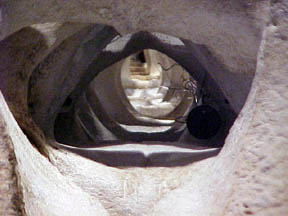 Woke
up in Rhode Island. Went to New Bedford again. Walking
down the cobblestoned street with my Modern Library
edition of Moby Dick under my arm I'm pretty sure
this is either a pilgrimage or a compulsion. Tourism's
got nothing to do with it. Come to think of it, what on
earth were those tourists from New Jersey that we ran
into at the Hetty Green Museum yesterday doing in New
Bedford in January? Why weren't they at Disneyworld or on
one of those "It's way more than a cruise! So get out
there!" cruises they advertise constantly on TV? Who
knows?
Woke
up in Rhode Island. Went to New Bedford again. Walking
down the cobblestoned street with my Modern Library
edition of Moby Dick under my arm I'm pretty sure
this is either a pilgrimage or a compulsion. Tourism's
got nothing to do with it. Come to think of it, what on
earth were those tourists from New Jersey that we ran
into at the Hetty Green Museum yesterday doing in New
Bedford in January? Why weren't they at Disneyworld or on
one of those "It's way more than a cruise! So get out
there!" cruises they advertise constantly on TV? Who
knows?
The crowd is much bigger this
morning.
The malassadas taste remarkably
like donuts. I have this memory of having really good
malassadas at the marathon some year or other but these
ain't them. Of course, now that we've had the best
malassadas outside of the Azores at the Blessed Sacrament
festa in Providence, we'll never be satisfied
again.
Upstairs in the room where the
Purrington & Russell panorama of a whaling voyage
around the world used to be on display they're
rearticulating the bones of a sperm whale that washed
ashore dead on Nantucket. It's 48 feet long and weighed
90,000 pounds. The first thing I noticed is that there is
absolutely zero whale oil smell. The bones are
unbelievably dry and white. Remembering back to when they
were rearticulating KOBO and how the smell of whale oil
permeated the entire museum, and how even now KOBO's
bones ooze a little oil I wondered what was different
about this whale rearticulation project.
A museum docent appeared, showing
two visitors who appeared to be friends of hers around
the sperm whale. They said they hadn't understood what
she meant when she told them they're rearticulating a
sperm whale but now they do. As sometimes happens when I
have a question, I couldn't wait patiently so I walked
over and asked the docent how come the sperm whale's
bones aren't oily like KOBO's.
She explained that the whale
rearticulation experts had advised a different method for
removing the flesh and treating the bones this time.
KOBO's body had been lowered into the sea to be stripped
of its flesh naturally, then the bones brought back to
the museum and rearticulation begun. The sperm whale's
body was towed, by boat and flatbed truck, to New
Bedford, where it they flensed it.
Then they buried the bones in
manure and straw for cleaning. As the manure decomposes,
the high temperature (it can reach up to 160 degrees F)
kills any insect infestations and forces the oil out of
the bones. Then, after they dug up the bare, cleansed,
bones they put it outside to bleach in the sun. That
explains the whiteness as well as the dryness. So the
bones were already clean and dry when the rearticulation
began.
The spine just got put together a
couple of days ago, and it's up on saw horses stretching
to its full length. Looking thru the spine where all
those nerves and stuff of life would be as if it were a
tunnel or some weird kind of kaleidoscope felt
disorienting. A lot like walking through its rib cage in
a Bower in the Aracides, come to think of it. In my
imagination anyway...